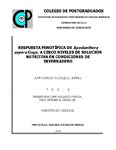| dc.contributor.author | Velázquez Juárez, Juan Carlos | |
| dc.creator | VELÁZQUEZ JUÁREZ, JUAN CARLOS; 738609 | |
| dc.date.accessioned | 2019-07-24T17:04:45Z | |
| dc.date.available | 2019-07-24T17:04:45Z | |
| dc.date.issued | 2019-07 | |
| dc.identifier.uri | http://hdl.handle.net/10521/3649 | |
| dc.description | Tesis (Maestría en Ciencias, especialista en Edafología).- Colegio de Postgraduados, 2019. | es_MX |
| dc.description.abstract | El pisto o chichicamole (Apodanthera aspera Cogn) es una planta silvestre y endémica del Valle de Tehuacán-Cuicatlán, México. Sus semillas poseen un alto valor comercial y nutricional, con potencial de explotación industrial para la obtención de aceite. Sin embargo, no existe información específica sobre la respuesta de esta especie al manejo y a la aplicación de fertilizantes. Por tal razón, el objetivo de la presente investigación fue evaluar la respuesta agronómica del pisto a la aplicación de solución nutritiva de Steiner a 0.22, 0.36, 0.50 y 0.72 atm. Las plantas fueron cultivadas en macetas con un sustrato de suelo y perlita expandida, bajo condiciones de invernadero. Las variables evaluadas fueron altura de planta, número de nudos, número de zarcillos, área foliar, peso seco de hojas, tallos, raíz y peso seco total. Además, se evaluó la distribución de la materia seca y se registró la aparición de órganos. Se encontró que la aplicación de la solución nutritiva tuvo un efecto positivo en las variables evaluadas con respecto al testigo. Con la aplicación de solución nutritiva a 0.36 atm se obtuvo el efecto en el mayor número de variables, ya que incrementó la altura de planta, número de nudos, área foliar, peso seco de tallos y hojas. La aplicación de solución nutritiva a 0.5 atm incrementó el número de zarcillos y peso seco de raíz. Por otro lado, la mayor cantidad de materia seca se presentó en la raíz, seguida de hojas y tallos. A pesar de ser una planta de hábito de crecimiento rastrero, la presencia de zarcillos indica que puede ser manejable con tutores, como la mayoría de las cucurbitáceas. Ambas características, la colocan como una especie susceptible de ser domesticada y mejorada para su explotación industrial. _______________ PHENOTYPIC RESPONSE OF Apodanthera aspera Cogn. AT FIVE LEVELS OF NUTRIENT SOLUTION UNDER GREENHOUSE CONDITIONS. ABSTRACT: The pisto or chichicamole (Apodanthera aspera Cogn) is a wild and endemic plant of the Tehuacán-Cuicatlán Valley, Mexico. The pisto seeds have a high commercial and nutritional value, with potential for industrial exploitation to obtain oil. However, there is no specific information on the response of this species to agronomic management and the application of fertilizers. For this reason, the objective of the present research was to evaluate the agronomic response of the pisto to the application of Steiner nutrient solution at 0.22, 0.36, 0.50 and 0.72 atm. The plants were planted in pots filled with a mixture of soil and expanded perlite in ratio 2:1. The variables evaluated were plant height, number of knots, number of tendrils, leaf area, dry weight of leaves, stems, root and total dry weight. In addition, the dry matter distribution was evaluated and the appearance of organs was recorded. It was found that the application of the nutritive solution had a positive effect on the variables evaluated. The best results were observed with the application of 0.36 atm nutrient solution due to the effect on a larger number of variables such as the increase in plant height, number of knots, leaf area, dry weight of stems and leaves. The application of 0.5 atm nutrient solution had an effect on the increase in the number of tendrils and root dry weight. On the other hand, it was identified that the greatest amount of dry matter is found in the root followed by leaves and stems. It is concluded that A. aspera is a plant that responds favorably to the application of nutritive solution. Despite being a plant with a creeping growth habit, the presence of tendrils indicates that it can be handled by tutors, like most cucurbits. Both characteristics, place it as a species susceptible of being domesticated and improved for its industrial exploitation. | es_MX |
| dc.description.sponsorship | Consejo Nacional de Ciencia y Tecnología (CONACyT). | es_MX |
| dc.format | pdf | es_MX |
| dc.language.iso | spa | es_MX |
| dc.rights.uri | http://creativecommons.org/licenses/by-nc-nd/4.0 | es_MX |
| dc.subject | Apodanthera aspera | es_MX |
| dc.subject | Silvestre | es_MX |
| dc.subject | Peso seco | es_MX |
| dc.subject | Solución nutritiva | es_MX |
| dc.subject | Wild | es_MX |
| dc.subject | Dry weight | es_MX |
| dc.subject | Nutritive solution | es_MX |
| dc.subject | Edafología | es_MX |
| dc.subject | Maestría | es_MX |
| dc.subject.classification | BIOLOGÍA Y QUÍMICA::CIENCIAS DE LA VIDA::BIOLOGÍA VEGETAL (BOTÁNICA)::BOTÁNICA GENERAL | es_MX |
| dc.title | Respuesta fenotípica de Apodanthera aspera Cogn. a cinco niveles de solución nutritiva en condiciones de invernadero. | es_MX |
| dc.type | Tesis | es_MX |
| Tesis.contributor.advisor | Espinosa Victoria, David | |
| Tesis.contributor.advisor | Volke Haller, Víctor Hugo | |
| Tesis.contributor.advisor | Vega Muñoz, Ricardo | |
| Tesis.date.submitted | 2019-07 | |
| Tesis.date.accesioned | 2019 | |
| Tesis.date.available | 2019 | |
| Tesis.format.mimetype | pdf | es_MX |
| Tesis.format.extent | 1,994 KB | es_MX |
| Tesis.subject.nal | Calidad de las semillas | es_MX |
| Tesis.subject.nal | Seed quality | es_MX |
| Tesis.subject.nal | Valor nutritivo | es_MX |
| Tesis.subject.nal | Nutritive value | es_MX |
| Tesis.subject.nal | Soluciones nutritivas | es_MX |
| Tesis.subject.nal | Nutrient solutions | es_MX |
| Tesis.subject.nal | Montecillo, Texcoco, Estado de México, México | es_MX |
| Tesis.rights | Acceso abierto | es_MX |
| Articulos.subject.classification | Plantas silvestres comestibles | es_MX |
| dc.type.conacyt | masterThesis | es_MX |
| dc.identificator | 2||24||2417||241703 | es_MX |
| dc.contributor.director | ESPINOSA VICTORIA, DAVID; 56073 | |
| dc.audience | generalPublic | es_MX |


